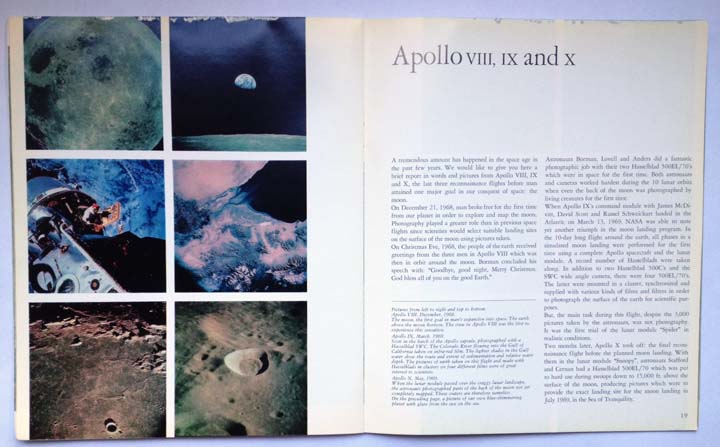Hasselblad in Space
In the Hasselblad House Magazine, Volume 3, 1970, the editors published several reports on the use of Hasselblad cameras in the NASA space program. Starting in 1962, the Swedish camera became the standard and with so many cameras being shipped to NASA, a special technical department was established at the factory in Gothenburg to work on the development of the cameras. Following is the introduction to the articles on Apollo missions VIII, IX and X.
A tremendous amount has happened in the space age in the past few years. We would like to give you here a brief report in words and pictures from Apollo VIII, IX and X, the last three reconnaissance flights before man attained one major goal in our conquest of space: the moon.
On December 21, 1968, man broke free for the first time from our planet in order to explore and map the moon. Photography played a greater role than in previous space flights since scientists would select suitable landing sites on the surface of the moon using the pictures taken.

On Christmas Eve, 1968, the people of the earth received greetings from the three men in Apollo VIII, which was then in orbit around the moon. Frank Borman concluded his speech with: “Good bye, good night, Merry Christmas. God bless all of you on the good Earth.”
Astronauts Borman, Lovell and Anders did a fantastic photographic job with their two Hasselblad 500El/70’s, which were in space for the first time. Both astronauts and cameras worked hardest during the 10 lunar orbits when even the back of the moon was photographed for the first time.
When Apollo IX’s command module with James McDivitt, David Scott and Russel Schweickart landed in the Atlantic on March 13, 1969, NASA was able to note yet another triumph in the moon landing program. In the 10-day long flight around the earth, all phases in a simulated moon landing were performed for the first time using a complete Apollo spacecraft and the lunar module....But the main task during this flight, despite the 3,000 pictures taken by the astronauts, was not photography. It was the first trial of the lunar module “Spider” in realistic conditions.

Photo top row, right: Earth above the moon's horizon, Apollo VIII, December, 1968.
Two months later, Apollo X took off; the final reconnaissance flight before the planned moon landing. With them in the lunar module “Snoopy,” astronauts Stafford and Cernan had a Hasselblad 500EL/70, which was put to hard use during swoops down to 15,000 ft. above the surface of the moon, producing pictures which were to provide the exact landing site for the moon landing in July 1969, in the Sea of Tranquility.


